High costs of new chipping equipment, coupled with a pet hate for forestry waste, were the two key factors that led Galway innovator Robert Brennan to build his own self-propelled wood chipper.
Starting from humble beginnings, Robert chipped away at the project on and off for two years, before finally putting his machine to work for the first time last week.
We travelled to Williamstown to see Robert put his first few loads of timber and brash through the machine.
The project took two years on and off and cost in the region of €70,000 to €80,000.
The project
A mechanic by trade, Robert has been involved in the forestry industry for the past 12 years and runs his own business, Brennan Forestry Machinery Ltd.
The company features a team of three harvesters and two forwarders. Robert runs a mix of John Deere and Ponsee equipment and his work is largely in Galway and the surrounding counties of Roscommon and Mayo.
A pet hate of his has always been forestry waste: “I regularly used to and continue to see a lot of waste timber and brash left to rot or be burnt in fields and forests when I’m on the road.
“Any timber that has been cut down has the potential to be turned into a fuel and I’ve always felt it was a shame to waste it when so much effort was put into planting it.
“Over the years I’ve thought about buying various pieces of equipment such as a brash baler, but the limited use and huge associated cost would always deter me.
“Two years ago, I finally decided to build my own self-propelled wood chipper. I decided to mount it on the body of an old forwarder. My thinking was that I would be able to travel and work in any type of environment with the machine.” 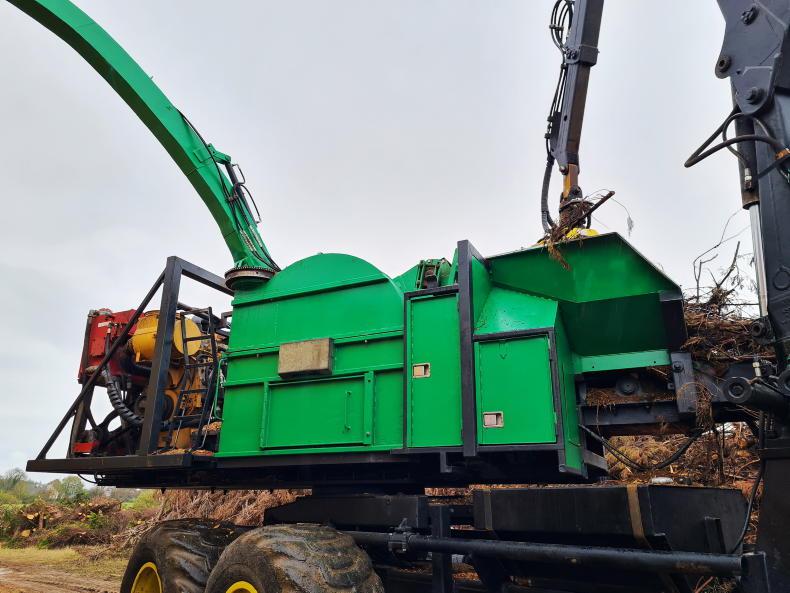
The 12-year-old Austrian built Starchl MK74 wood chipper had been out of use for several years and was picked up in Donegal.
Humble beginnings
Towards the end of 2019, Robert struck off to west Mayo where he purchased a shook-looking 20-year-old John Deere 1110C timber forwarder.
A fan of the build quality and output capacity of the older John Deere forwarders, he noted that machines of this era were years ahead of their time.
However, the machine he purchased had been idle for 10 years and was in need of a full engine, transmission and hydraulic pump overhaul. In saying that, the electrics were perfect.
The huge workload didn’t faze Robert and he purchased the unit for €10,000.
Soon after, he headed for Donegal, where he located a 12-year-old Austrian-built Starchl MK74 wood chipper. The chipper was engine-driven and came on its own trailer unit.
Similar to any chipper, big or small, the conveyer feeds the drum (fitted with stepped knives), which chops the timber and discharges it through the screen into the auger, which feeds the blower before the final product exits through the chute.
With an output capacity in the region of 20t to 25t per hour, the chipper had a buying price in the region of €250,000 back in its heyday in 2008.
Similar to the John Deere forwarder, the Starchl chipper was also very much out of action and had been for several years. Robert picked it up for €27,000.
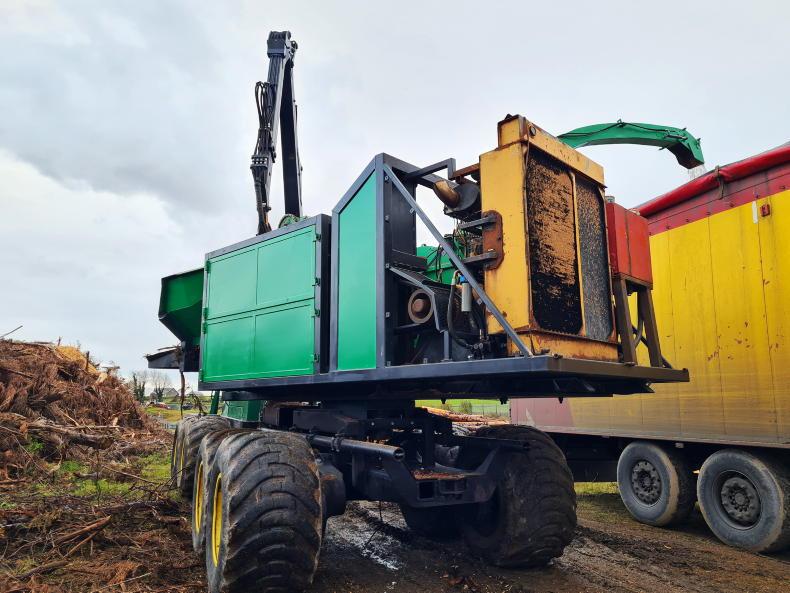
A second-hand lorry engine was sourced to run the chipper, namely a 325hp CAT C10 at a cost of €2,000.
Once the dirty work began, he swapped out the engine in the forwarder for a similar-sized spare engine he had in his yard.
He started overhauling the transmission by himself. Meanwhile, a used crane and grapple were sourced and swapped in for the existing worn-out version.
Although it was something he hadn’t seen done before on a forwarder, Robert decided to mount a slew ring between the machine’s chassis and the chipper unit.
The slew ring was sourced in Northern Ireland and was originally used in a Tekeuchi tracked dumper, which had been converted to a cherry picker.
By fitting the slew ring, Robert would be able to slew the chipper unit by 90° either side of the chassis. This, combined with the forwarder’s articulation point, meant the operator would always be facing his or her work, no matter where the working environment might be.
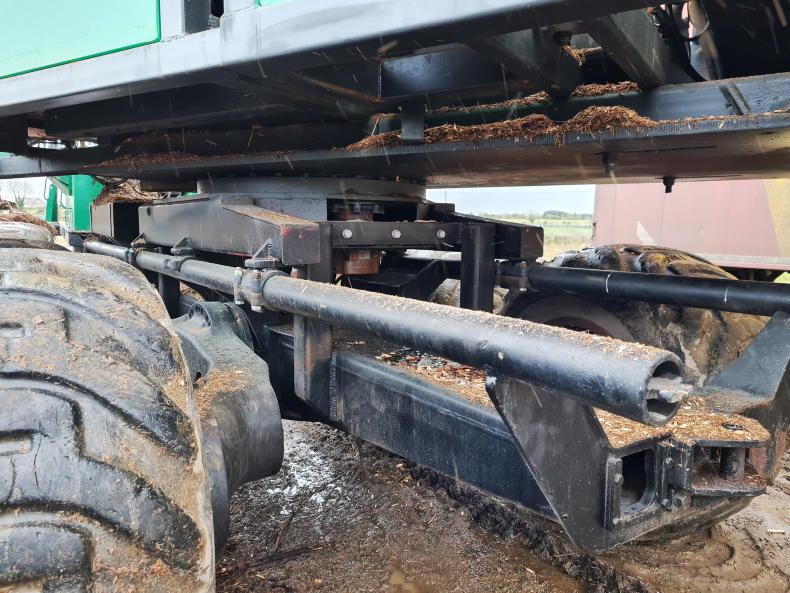
Robert decided to mount a slew ring in between the chassis and the chipper unit, meaning he could slew the unit by 90° either side of the chassis.
And the shopping spree of parts and components didn’t stop there. A second-hand lorry engine to run the chipper, namely a 325hp Cat C10, was sourced in Cork at a cost of €2,000.
Before mounting the engine or chipper on to the forwarder, a frame was constructed and mounted on to the chassis.
This involved some thought as the engine was now mounted closer to the chipper than its original design. Once the chipper and engine had been married up and gone through in-depth mechanically, Robert took to fabricating new panels and safety guards. 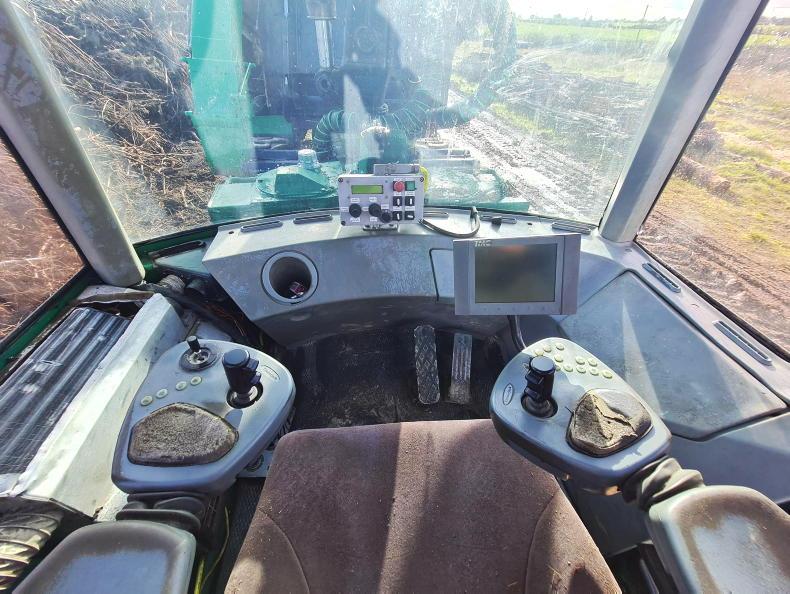
Robert is going to convert the two major chipper controls, the intake speed and the intake opening size from switch control on the box to pedal control.
Final modifications
We caught up with Robert as he began chipping his second artic load of waste timber with the home-built machine.
He said he had very few teething issues and the machine only needed minor adjustments here and there. Although the working unit now appeared complete, Robert said he has some wiring modifications he wants to make shortly.
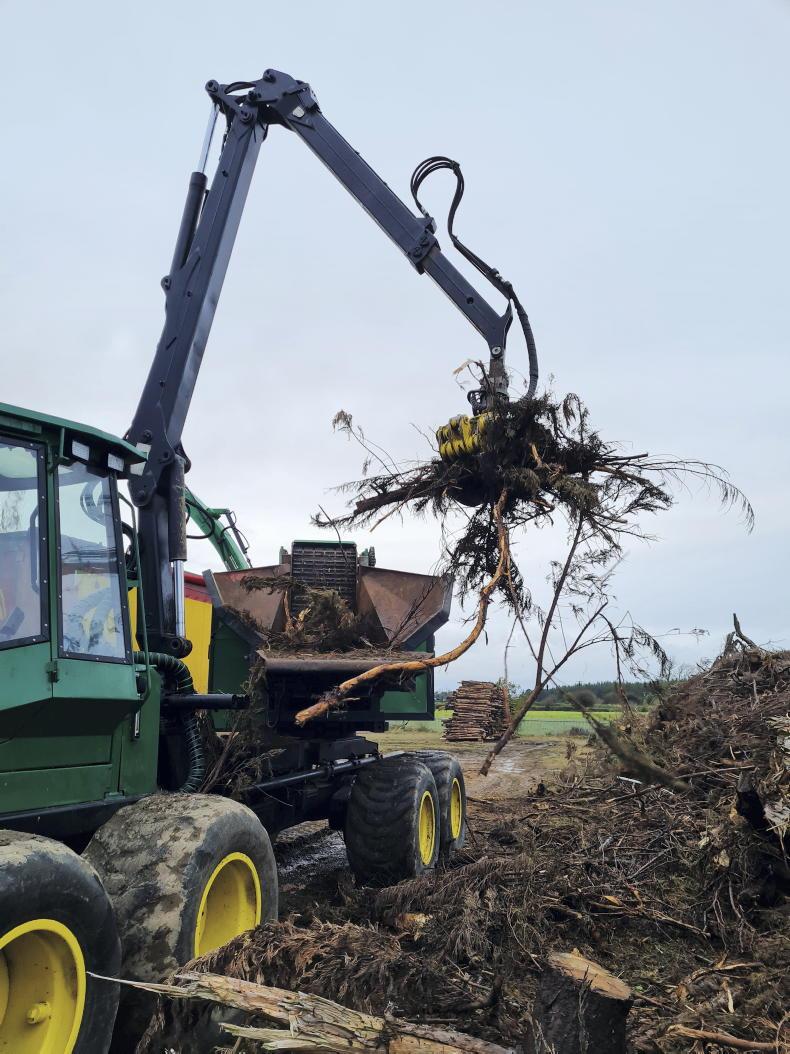
A used crane and grapple were sourced and swapped in for the existing worn-out version.
The chipper has its own control box, while the forwarder features its original twin joystick controls.
Robert is going to convert the two major chipper controls, the intake speed and the intake opening size from switch control on the box to pedal control.
He said such a conversion will mean the operator will very rarely have to lift his or her hands off the two joysticks throughout a typical working day.
The chipper engine currently has to be started with a key and the clutch engaged from outside the cab, although it can be revved from the cab. Robert plans to move all the engine controls to the cab in time. 
With an output capacity in the region of 20-25t/h, Robert noted the original chipper unit had a buying price in the region of €250,000 in 2008.
Costings to date
It’s difficult to put a cost on a comparable new self-propelled chipping unit in today’s market, largely because no one offers such a design.
Aside from the associated costs outlined above, other hidden costs included the steel (€3,000 to €4,000), some additional labour for subbed-out fabrication, a full 360° LED lighting kit and the addition of new hydraulic hoses all round. The machine was also fully shot-blasted, primed, and finished with two-pack paint.
Not taking into account the many man hours late at night and early in the mornings, Robert estimates that the machine cost him somewhere in the region of €70,000 to €80,000. 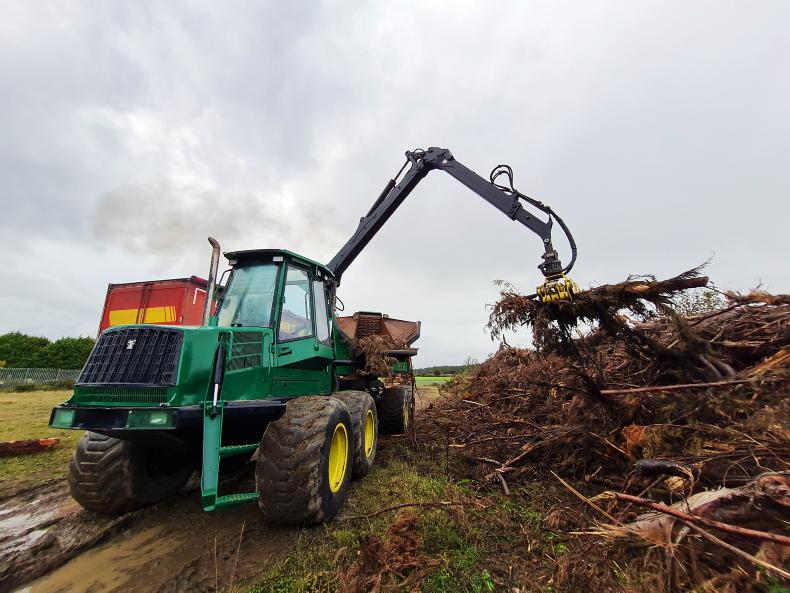
What next?
Now that the project is almost complete, Robert said he has no set plan for the machine. As part of his timber harvesting business, he also carries out some site clearance and feels the machine has the potential to play a role with this kind of work. Rather than being forced to draw timber and brash away at an additional cost, it can now be chipped on site. He also noted that it could play a role in chipping timber for use as a biomass fuel source.


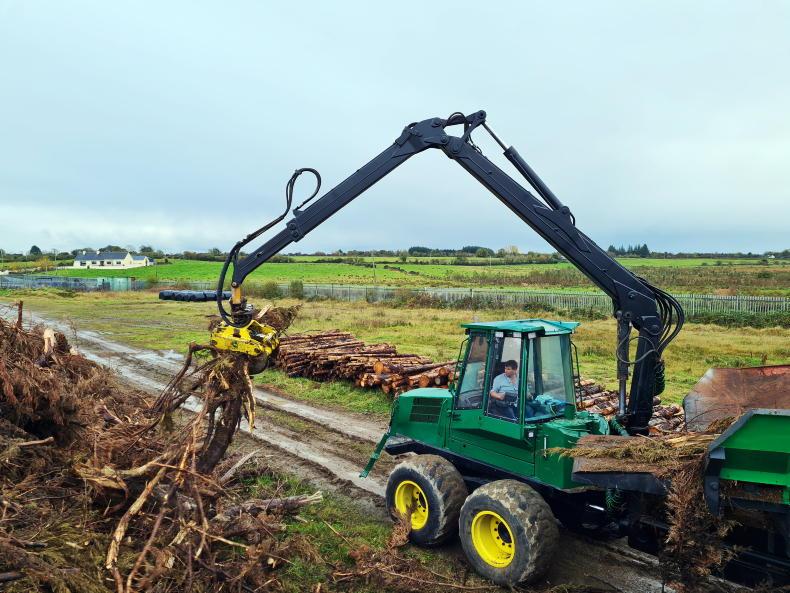
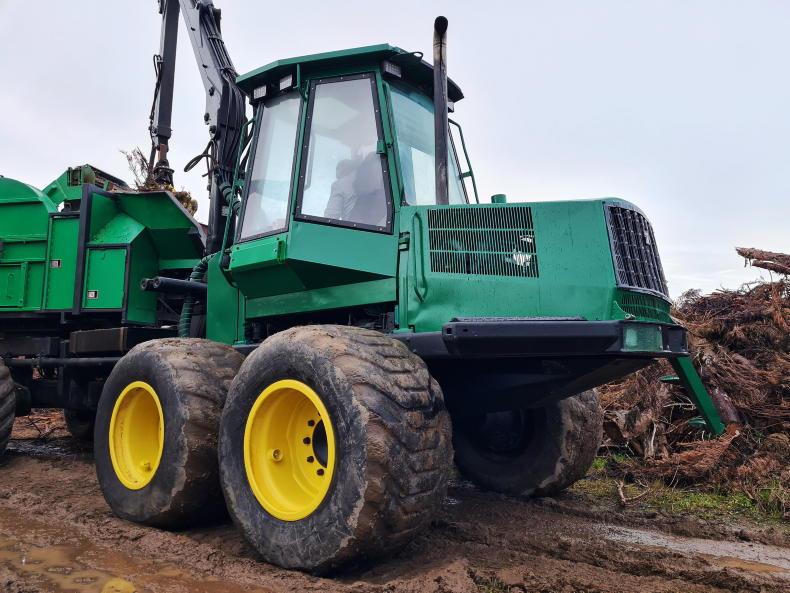
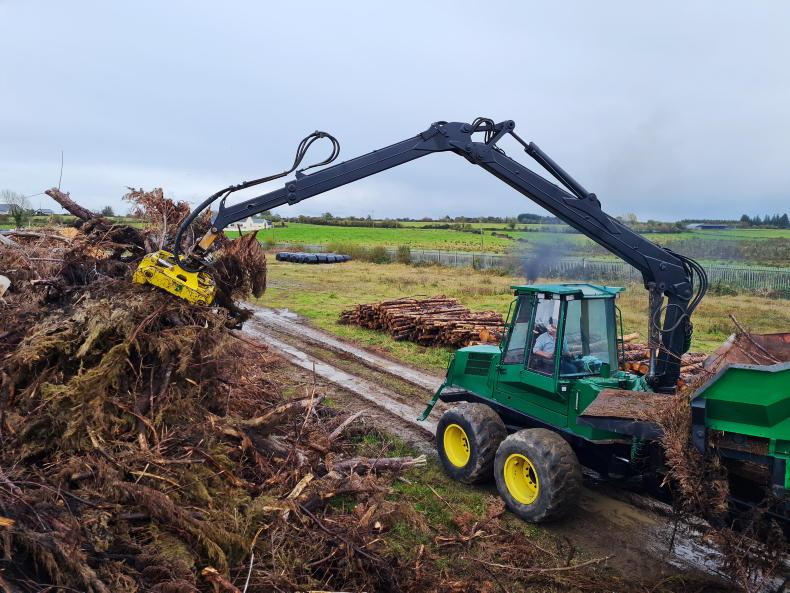
High costs of new chipping equipment, coupled with a pet hate for forestry waste, were the two key factors that led Galway innovator Robert Brennan to build his own self-propelled wood chipper.
Starting from humble beginnings, Robert chipped away at the project on and off for two years, before finally putting his machine to work for the first time last week.
We travelled to Williamstown to see Robert put his first few loads of timber and brash through the machine.
The project took two years on and off and cost in the region of €70,000 to €80,000.
The project
A mechanic by trade, Robert has been involved in the forestry industry for the past 12 years and runs his own business, Brennan Forestry Machinery Ltd.
The company features a team of three harvesters and two forwarders. Robert runs a mix of John Deere and Ponsee equipment and his work is largely in Galway and the surrounding counties of Roscommon and Mayo.
A pet hate of his has always been forestry waste: “I regularly used to and continue to see a lot of waste timber and brash left to rot or be burnt in fields and forests when I’m on the road.
“Any timber that has been cut down has the potential to be turned into a fuel and I’ve always felt it was a shame to waste it when so much effort was put into planting it.
“Over the years I’ve thought about buying various pieces of equipment such as a brash baler, but the limited use and huge associated cost would always deter me.
“Two years ago, I finally decided to build my own self-propelled wood chipper. I decided to mount it on the body of an old forwarder. My thinking was that I would be able to travel and work in any type of environment with the machine.” 
The 12-year-old Austrian built Starchl MK74 wood chipper had been out of use for several years and was picked up in Donegal.
Humble beginnings
Towards the end of 2019, Robert struck off to west Mayo where he purchased a shook-looking 20-year-old John Deere 1110C timber forwarder.
A fan of the build quality and output capacity of the older John Deere forwarders, he noted that machines of this era were years ahead of their time.
However, the machine he purchased had been idle for 10 years and was in need of a full engine, transmission and hydraulic pump overhaul. In saying that, the electrics were perfect.
The huge workload didn’t faze Robert and he purchased the unit for €10,000.
Soon after, he headed for Donegal, where he located a 12-year-old Austrian-built Starchl MK74 wood chipper. The chipper was engine-driven and came on its own trailer unit.
Similar to any chipper, big or small, the conveyer feeds the drum (fitted with stepped knives), which chops the timber and discharges it through the screen into the auger, which feeds the blower before the final product exits through the chute.
With an output capacity in the region of 20t to 25t per hour, the chipper had a buying price in the region of €250,000 back in its heyday in 2008.
Similar to the John Deere forwarder, the Starchl chipper was also very much out of action and had been for several years. Robert picked it up for €27,000.

A second-hand lorry engine was sourced to run the chipper, namely a 325hp CAT C10 at a cost of €2,000.
Once the dirty work began, he swapped out the engine in the forwarder for a similar-sized spare engine he had in his yard.
He started overhauling the transmission by himself. Meanwhile, a used crane and grapple were sourced and swapped in for the existing worn-out version.
Although it was something he hadn’t seen done before on a forwarder, Robert decided to mount a slew ring between the machine’s chassis and the chipper unit.
The slew ring was sourced in Northern Ireland and was originally used in a Tekeuchi tracked dumper, which had been converted to a cherry picker.
By fitting the slew ring, Robert would be able to slew the chipper unit by 90° either side of the chassis. This, combined with the forwarder’s articulation point, meant the operator would always be facing his or her work, no matter where the working environment might be.

Robert decided to mount a slew ring in between the chassis and the chipper unit, meaning he could slew the unit by 90° either side of the chassis.
And the shopping spree of parts and components didn’t stop there. A second-hand lorry engine to run the chipper, namely a 325hp Cat C10, was sourced in Cork at a cost of €2,000.
Before mounting the engine or chipper on to the forwarder, a frame was constructed and mounted on to the chassis.
This involved some thought as the engine was now mounted closer to the chipper than its original design. Once the chipper and engine had been married up and gone through in-depth mechanically, Robert took to fabricating new panels and safety guards. 
Robert is going to convert the two major chipper controls, the intake speed and the intake opening size from switch control on the box to pedal control.
Final modifications
We caught up with Robert as he began chipping his second artic load of waste timber with the home-built machine.
He said he had very few teething issues and the machine only needed minor adjustments here and there. Although the working unit now appeared complete, Robert said he has some wiring modifications he wants to make shortly.

A used crane and grapple were sourced and swapped in for the existing worn-out version.
The chipper has its own control box, while the forwarder features its original twin joystick controls.
Robert is going to convert the two major chipper controls, the intake speed and the intake opening size from switch control on the box to pedal control.
He said such a conversion will mean the operator will very rarely have to lift his or her hands off the two joysticks throughout a typical working day.
The chipper engine currently has to be started with a key and the clutch engaged from outside the cab, although it can be revved from the cab. Robert plans to move all the engine controls to the cab in time. 
With an output capacity in the region of 20-25t/h, Robert noted the original chipper unit had a buying price in the region of €250,000 in 2008.
Costings to date
It’s difficult to put a cost on a comparable new self-propelled chipping unit in today’s market, largely because no one offers such a design.
Aside from the associated costs outlined above, other hidden costs included the steel (€3,000 to €4,000), some additional labour for subbed-out fabrication, a full 360° LED lighting kit and the addition of new hydraulic hoses all round. The machine was also fully shot-blasted, primed, and finished with two-pack paint.
Not taking into account the many man hours late at night and early in the mornings, Robert estimates that the machine cost him somewhere in the region of €70,000 to €80,000. 
What next?
Now that the project is almost complete, Robert said he has no set plan for the machine. As part of his timber harvesting business, he also carries out some site clearance and feels the machine has the potential to play a role with this kind of work. Rather than being forced to draw timber and brash away at an additional cost, it can now be chipped on site. He also noted that it could play a role in chipping timber for use as a biomass fuel source.
























 This is a subscriber-only article
This is a subscriber-only article










SHARING OPTIONS: